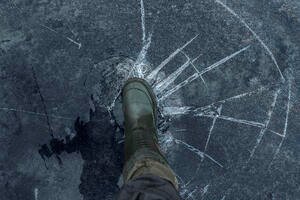If you live on or near a lake, you know how much fun you can have participating in winter activities. Ice skating, fishing, and snowmobiling are just a few. However, fun can turn into tragedy if you’re not careful and you fall through. Ice thickness is a tricky thing to gauge. There are so many variables that affect the depth and strength of the ice.
Below are some things to be aware of the next time you venture out onto a frozen lake or pond.
Before heading out on the ice
It’s important to talk with the local bait shop, lakeside resort, or a local resident about ice conditions. Making consistent ice is a tough job for Mother Nature. Here are some ice characteristics to be aware of:
- New ice is stronger than old ice.
- Underwater currents make it difficult for ice to form.
- A fresh snowfall slows down the creation of ice and adds weight.
- If you hear booming or cracking, it doesn’t mean the ice is unsafe. Ice is shifting due to temperature changes.
Here are some ice thickness guidelines to follow:
- 2″ or less – STAY OFF!
- 4″ – Ice fishing or other activities on foot
- 5″ – Snowmobile or ATV
- 8″ – 12″ – Car or small pickup
- 12″ – 15″ – Medium truck
Survival tips if you fall through thin ice
- Remain calm. If you fall through the ice, do your best to stay calm. While it’s a very scary situation, don’t flail your arms. This only wastes valuable body heat and energy. Concentrate on staying afloat. It’s estimated after about 10 minutes in the water, hypothermia will set in.
- Focus on controlling your breathing. Due to the extreme coldness of the water, the shock to your body will be intense. Your body’s natural reaction is to gasp for air which can lead to hyperventilating. Hyperventilating can decrease your odds of getting out of the water alive.
- Floating horizontal is key. If your body is vertical, it’s nearly impossible to pull yourself out. The ice is slippery, and your wet clothes may be weighing you down. Try to get yourself into a horizontal floating position. Then, kick as hard as you can to try and get yourself to slide horizontally onto the ice.
- Call for help. If friends or family are nearby, call for help. However, it’s important that they stay away from the hole, so they don’t fall in. Their best option is to throw you a rope, branch, or anything that you can grab on to. Pulling you out is the safest option for everyone.
- Don’t stand up. Once you get out of the water, your instinct may be to immediately stand up to walk back to shore. Standing up could cause you to fall back into the water. Your best chance of survival is to roll over the ice until you can reach safety.
- Warm up slowly. Once you’ve made it back to safety, it’s time to start focusing on warming up your body. Hypothermia can still occur after getting out of the frigid water. Here are things to do:
- Find shelter in a building or car.
- Remove wet clothes.
- If you still have energy afterwards, continue moving to keep your blood flowing.
- Drink warm beverages.
Remember, temperature, snow cover, and currents, all affect ice safety. Ice is rarely the same thickness over a single body of water. With common sense and precaution, you’ll enjoy the winter season safely outdoors.
Do you have any tips or information you’d like to share? I’d love to hear them; please share them in the box below.
Source:


